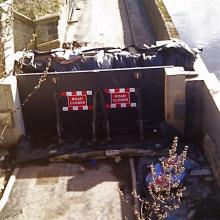
Phase 1 of floodworks along the Water of Leith (from Bonnington to Stockbridge) is due to finish in August this year. After mediation between the Council and contractors Lagan, a final outturn cost for this has been set at £29.132 million.
The estimated outturn cost of Phase 1 at the time of the construction contract's award was £22.683m. Lagan blames unexpected ground conditions, piling problems, and poor weather for the increase.
As the public quite understandably mutters about escalating expense and the endlessly reinterpretable nature of major contracts, it is perhaps worth remembering why this major engineering scheme was considered necessary in the first place.
Edinburgh experienced widespread flooding in 1948, 1984, 1990 and 1993, but easily the worst such event occurred on 26 April 2000. Following 11.2 cms of rain in the 48 hours preceding, East of Scotland's 'compensation reservoirs' upstream had reached capacity by 8.45pm and rivers across the city soon overtopped thereafter.
Neale Gilhooley's photo (above-right) shows recently installed floodgates on Warriston Road (see also Issue 218). Tim Smith's photos below show what happened in 2000.

Houses on Warriston Crescent were inundated, and boundary walls at Warriston Road (below) and Bonnington collapsed, resulting in widespread damage along Logie Green Road and beyond Redbraes Weir. Across the city similar flooding of the Braid and Gogar Burns led to a combined total of 500 damaged properties. The cost of the floods was calculated at £25m.

The Scottish Environment Protection Agency initially said this was a 1 in 180-year event, but later suggested a more frequent 'return period' of 100 years. Anthony Gormley's 'Six Times' figures mounted in the river have also fallen victim to more frequent than predicted high water pressures since their installation in 2010 (Breaking news, 5.11.12).
The area of open land which formerly accommodated Powderhall Stadium once acted as a floodplain. Eyebrows were therefore raised when a raised housing development was built here soon after the flood. Many locals predicted additional run-off and the river seeking new spots to overflow downstream.

Statistics suggest a general trend for more flooding events. On the basis of figures collected since 1968, the Water of Leith's two highest flows have come since the beginning of 2000, with most occurring between June and August or October and November.
Experts say climate change is likely to add to the frequency and severity of such flow peaks in future, but completion of Phase 1 is expected to protect 1,532 residential and 78 commercial properties.
A report on the Water of Leith Flood Prevention Scheme – and recent sensitive negotiations with Lagan – will go before a Full Council Meeting tomorrow (see Full Meeting Papers and click on Item 8.5) . 'Only' £19.961m now remains in the Council's budget to complete future phases, and a report on this aspect of the scheme will be presented in June.
What do you think of Edinburgh's rising floodwork costs? Do you have photos of the 2000 event? Contact us by email: spurtle@hotmail.co.uk Twitter: @theSpurtle Facebook: Broughton Spurtle
--------------------------
Reaction
See Harald Tobermann's critical assessment of the floodworks in Letters (9.5.13).